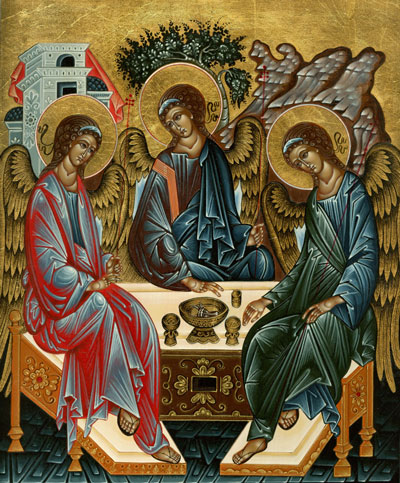Saint Justin Martyr on the Trinity
Posted by Andrew Haines in Church Doctrine, Saints, Theology on 4.07.2008
 Looking for ways to articulate the mystery of the Holy Trinity is perhaps the single oldest quest in Catholic theology. No metaphor or analogy comes close to capturing such a transcendent yet necessary reality of our faith in God the Father, Son and Holy Spirit. However, some images serve us better than others; generally the simpler the better, since simplicity is truly the substance of God, whose essence is his very existence. One of my favorite analogies for the Trinitarian procession—the inherent relationship between Father, Son and Spirit—is St. Justin Martyr’s image of light. Even in the Nicaean Creed, which Catholics profess every Sunday at Mass, this basic yet profound metaphor is retained and proclaimed as a fundamental articulation of the Trinitarian mystery: we believe in Jesus Christ as “God from God, Light from Light, True God from True God, begotten not made, one in being with the Father.”
Looking for ways to articulate the mystery of the Holy Trinity is perhaps the single oldest quest in Catholic theology. No metaphor or analogy comes close to capturing such a transcendent yet necessary reality of our faith in God the Father, Son and Holy Spirit. However, some images serve us better than others; generally the simpler the better, since simplicity is truly the substance of God, whose essence is his very existence. One of my favorite analogies for the Trinitarian procession—the inherent relationship between Father, Son and Spirit—is St. Justin Martyr’s image of light. Even in the Nicaean Creed, which Catholics profess every Sunday at Mass, this basic yet profound metaphor is retained and proclaimed as a fundamental articulation of the Trinitarian mystery: we believe in Jesus Christ as “God from God, Light from Light, True God from True God, begotten not made, one in being with the Father.”
I think St. Justin’s analogy draws its force from our primal fascination with fire, the same fascination that wound up granting fire a key place in the high celebrations of the Catholic liturgical life (i.e. the Easter Vigil, baptisms, and at every Mass in the candles on the altar and in the procession). We obviously see fire as something bordering on the transcendent: it destroys yet brings life; it is a glimpse of the redemptive suffering of Christ on the Cross. There is just something mesmerizing about fire and about light. Even Jesus says that he is the Light, and that he has come to set the earth on fire. How fitting then that Justin uses this foundational element of human existence in expressing the mystery of Trinitarian existence.
In Justin’s analogy, just as one can light a second flame from a first, so too the Son is begotten of the Father. The Son’s existence, like the second flame, does not diminish the brilliance of the first Flame; both shine just as brightly as the other. Similarly, the Holy Spirit is a third flame, formed form the first two and shining just as brightly. While we can distinguish between the ‘flames’ proper—that is between their function as individual tongues of fire—we cannot distinguish between their substantial composition: they are all three fire. This relationship of ‘consubstantiality’ between the three flames is directly related to the consubstantial relationship of Father, Son and Holy Spirit; we can distinguish their function as Persons, but never their substance, since they share in one substance and are therefore one God.
Saint Justin Martyr, an early Father of the Church, was steeped in the tradition of Greek philosophy, so using earthly elements to convey transcendental truth was not uncommon. What amazes me about his analogy is the beautiful clarity with which we see a reflection of the divine in the spatio-temporal world. Although we cannot capture the mystery of God in words or even in thought or analogy, we must inevitably see the image of the Trinity in our daily experience, just as a reflection is seen in a mirror. If we capture the reflection, we have destroyed its nature, for then it is no longer a reflection of a higher reality but an independently existing one that is tangible and ‘real.’ The same is true of our perception of the Trinity in the world; if we were to capture it completely with our minds, it would no longer be a mystery, which is essential to its nature as the transcendent and divine being. Justin saw this clearly, and he expressed it beautifully. Hopefully his brilliant reflections and humble submission to the almighty power of God—Father, Son and Holy Spirit, consubstantial with one another yet distinct in their personhood—will inspire us to further submit our own intellects and wills to so great and majestic a Deity as the Holy Trinity.
This entry was posted on 4.07.2008 at 2:37 AM and is filed under Church Doctrine, Saints, Theology. You can follow any responses to this entry through the RSS 2.0. You can leave a response.



Post a Comment